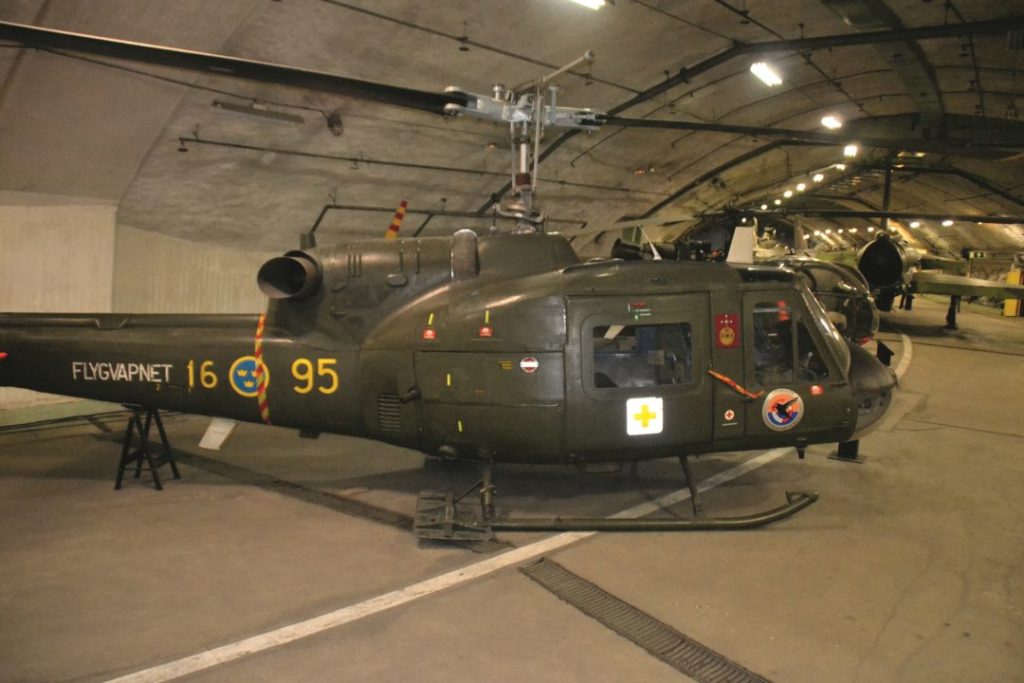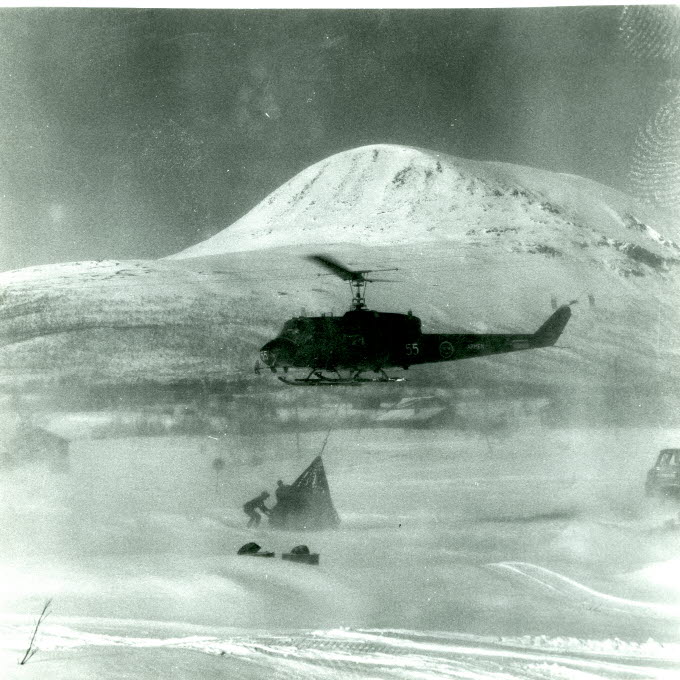Medium size helicopter wanted
As usual, Sweden followed developments in the rest of the world, but also drew on its own experiences in its newly formed helicopter units. Whilst the HKP 1 and HKP 2 met the needs of the Swedish Navy, the experience of Swedish Army Aviation was somewhat different. The HKP 2 worked generally well, but had limitations in respect of its load capacity. What was really wanted was a heavier, or at least a medium size helicopter with a greater transport capacity than the HKP 2 in respect of materiel, stretchers and personnel. So in 1959 the Swedish Army began to look around for a suitable machine.
Meanwhile, the Swedish Air Force had begun to re-evaluate its position with regard to helicopters, not least considering their ability to rapidly go anywhere and to participate in rescue operations. The Air Force had an aviation rescue organisation that could quickly pick up pilots who had been forced to eject from their aircraft. This organisation went under the name of the Aviation Rescue Group (Flygräddningsgruppen – FRÄD) and consisted from its foundation in 1947 of three Catalina amphibian aircraft, with the Swedish designation Tp 47.
One of these Catalinas was shot down in 1952 by a Soviet fighter while it was searching for potential survivors from a vanished DC-3 over the Baltic Sea.
The idea was that a medium size helicopter could form the basis of local FRÄDs, spread out across the country. Such a helicopter could also rescue people anywhere in Sweden, which amphibian aircraft could not do.
It therefore turned out that both the Swedish Army and Air force became interested in the ”Huey”. For various reasons it was decided to turn to Italy, where the Agusta company was manufacturing helicopters under licence, known as the Agusta-Bell 204. In the end 19 machines were ordered, 12 for the Swedish Army and 7 for the Air Force. These helicopters were designated HKP 3, the first being delivered in 1962.

HKP 3 number 95, which served as a FRÄD helicopter in the Swedish Air Force.
Note the humming bird symbol on the door.
Problems and modifications during service introduction
All did not go however as smoothly as wished in respect of these new helicopters. Their 1,000 hp Rolls-Royce Gnome engines, designated TM2A in Sweden were not actually as powerful as they could have been, and were also plagued with various types of breakdown, Among other things this led to the local daily newspaper NSD ”Norrländska Socialdemokraten” calling the HKP 3 ”the Army’s unlucky bird” on 4 Maj 1964.
In order to solve the problems, a rebuild of the HKP 3 commenced, in which the engines were replaced by newer and more powerful 1,250 hp Bristol Siddeley H1200 engines that became known as the TM2B. The rebuilt helicopters were designated HKP 3B.
During this period, three new HKP 3s were purchased, using money from the United Nations, so that the Swedish Army could build up a readiness platoon with three helicopters available for United Nations service. These had longer rotor blades than the standard HKP 3s which increased their speed and load-carrying capabiility. In light of this the Swedish Army commenced a new rebuuilding programme in which all its HKP 3s were similarly equipped with longer rotor blades and tail booms. All the machines had been rebuilt by 1969 and redesignated HKP 3C.
A workhorse
Whilst the Swedish Air Force HKP 3s were mainly employed in rescue tasks, the Army Aviation’s HKP 3s had much more varied tasking. The principal use for the Army helicopters was transportation, of troops, wounded soldiers and also materiel.
In the case of the wounded, up to 6 stretchers could be carried. Most often however three stretchers would be accommodated, so that medical personnel and sitting wounded could also fit in. In the case of troop transport, there were various alternatives, depending the type of troops to be carried. Normally this would be eight fully equipped soldiers, i.e. a normal infantry group. Larger weapons such as machine guns or mortars could be placed on the floor, between the two rows of seats that were fitted.
If riflemen were to be flown in behind enemy lines in wintertime, the front row of three seats would be removed to make room for skis and a sledge to carry equipment. This was in addition to five riflemen and their gear.
Materiel transport could take place either with an internal or external load, in the latter case hanging beneath the helicopter. Usually the external load could be up to 1,800 kilograms, most often no more than 1,000 or 1,200 kg.
The Army’s helicopters could also be equipped with winches and, just like the Air Force HKP 3s, used for rescue missions as rquired. However the Air Force FRÄD units were the true experts when it came to verstile rescue tasks and were the first to be called out when the occasion demanded.
The ability to carry heavy suspended loads was also useful when fighting forest fires. These helicopters were equipped with a container holding 540 litres or more of water. This could be filled by lowering it into a nearby water source or lake that was deep enough, while the helicopter was hovering. Thus a helicopter could perform water bombing several times before having to return to base to refuel.
Rivalry between military units
At Boden, in Norrbotten county lies Sweden’s largest military garrison. The town itself grew after a fortress began to be built there in 1900, and more and more military units used it as a base. In 1902 general conscription was introduced, and thousands of conscripts arrived every year, leading to both good and ill for the local inhabitants.
At this location was also housed the Army Aviation Battalion no. 1, abbreviated as AF 1, from where a large part of the Swedish Army helicopter operations took place. Army fliers had a dark blue beret, which meant that their conscripts and staff had to undergo a special beret test with extra strict conditions in oder to wear them. Due to this the berets were associated with being in a special elite, similar to paratroopers, coastal defence forces and other infantry units such as the armoured units with black berets.
Hence these dark blue berets were irritating to conscripts in the two next-door regiments, Boden’s Engineering Regiment Ing 3 and Boden’s Artillery Regiment A 8.
”From 1993 to 1994 the author of this article, Mattias Isaksson, was a conscript in the Boden’s Artillery Regiment as a signaller and all-terrain vehicle driver in a staff company. Seeing other conscripts who were part of the staff, nechanics who really had a less ”demanding” service than us, proudly wearing their berets annoyed us intensely. To us the berets should have signified elite soldiers who fought in the front line or even behind enemy lines, so why should the AF 1 conscripts wear these berets and not us! So it could happen sometimes that when we passed them on guard or in town we would say ”Basker blå, lätt att få!” (Blue beret, easy to get). Not the most mature behaviour.”
A surprising ride
”As members of the staff, we didn’t consider ourseves to be part of the elite, but at the same time we were perhaps a little sharper than the others. But when the other platoons did their survival weeks and then told everyone about the hardships they had suffered during those weeks, it felt as if we perhaps were not as tough as they were. Staff people such as us would hardly be able to manage such a severe test. Or could we?”
”One winter evening we noted that the schedule for the next day was rather cryptic. It broke the pattern of what we were used to. We were to parade in full battle order without being told what particular exercise was on hand. It was clear that our captain had something on his mind, and we guessed that it would involve some sort of survival exercise. So when we assembled next morning we were laughing and smiling as our captain, Göran Myllimäki, marched up to us in full battle order in his snow uniform with a cunning smile on his lips.”
”To start with he was rather proud that we had managed to figure out what was coming, but soon returned to normal and with a glint in his eye announced that we were to march across to the Army Aviation unit as our platoon had a special task. Our pulses quickened as it gradually dawned on us during the brief march over to AF 1 that we, the Central platoon, were to do something that none of the other platoons in our regiment would do. It appeared that we would fly away and perform a landing by helicopter!”
”We were met by the sight of two HKP 3Cs that were standing, warming up their engines, on the airfield. No. 1 Group would fly in the first and No. 2 Group follow in the second helicopter. We had a brief rundown on how to safely approch and depart from a helicopter with is rotors turning, where not to go and how to get in and out in a safe manner. We put on ear defenders and at the appointed time stepped forward and entered the machine. Even with ear defenders, the noise was incredible and we could scarcely communicate with each other by signs, to some extent by lipreading. The sensation was indescribable, almost a mixture of terrifying wonder and a certain amount of anxiety.”

The Åbergs fort, part of the Bodens fortress. Photo Bengt. A Lundgren
”To start with our pilot climbed straight up a few hundred metres to provide us with a beautiful view over the town of Boden and the fortifications on the tops of the hills. So far so good. Then the helicopter rapidly descended and we began to fly at treetop height and through valleys, so it was a surprise to me that no-one had their breakfast return back up. Even today there is no attraction in any fairground that could be better than that flight. I don’t remember how long it lasted, but eventually we arrived safe and sound at our landing area, which was a clearing in the forest. No. 1 Group commander stood to show where to land, and no-one envied him as the helicopter landed and enveloped him in a swirling cloud of blown snow.”

An HKP 3 unloads materiel in a winter landscape. Photo Svensk Militärhistoriskt Bibliotek
”There was however no more time to think about it, just to open the doors, step into the snow cloud and rush to our temporary defensive positions. As soon as we were out and taking cover, the helicopter accelerated, and to the characteristic thudding sound from the large two-bladed rotor the HKP 3, disappeared into the whirling snowflakes and vanished above the treetops. Left behind were two groups of conscripted soldiers hearing the fading sound of the helicopter. They realised that even though their survival exercise was probably only to be shorter (which it actually was), than those of their rivals, it had been much more memorable and dramatic, something we would remember for the rest of our lives.”
A long and eventful history
In 2001 the Swedish Defence Forces took the HKP 3s out of service after 39 years. However all around the world many Bell 204s continue to be used in a wide range of versions, both civilian and military. Only the UH-60 ”Blackhawk” could complete with the old ”Huey” in being the world’s most well known helicopter.
